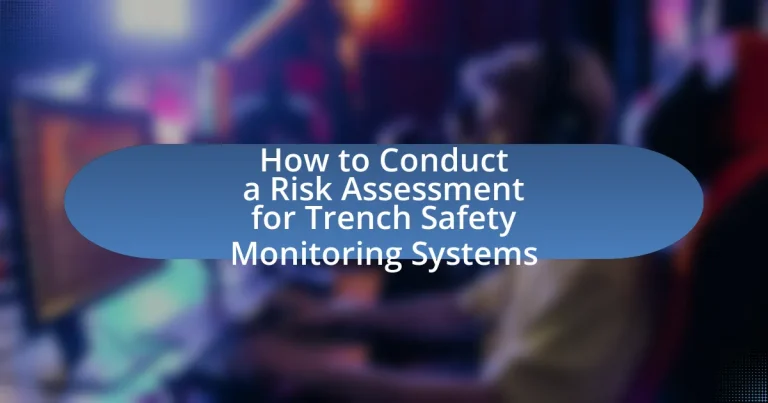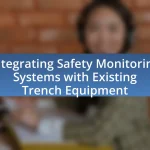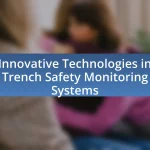A Risk Assessment for Trench Safety Monitoring Systems is a critical process that identifies and evaluates risks associated with trenching operations, focusing on hazards such as soil instability, water accumulation, and equipment failure. This assessment is essential for implementing safety measures to prevent accidents, particularly cave-ins, which are a leading cause of fatalities in construction. Key components of the assessment include hazard identification, risk evaluation, and the establishment of control measures, all governed by regulations from organizations like OSHA. The article outlines methodologies for conducting risk assessments, the importance of continuous monitoring, and best practices for enhancing trench safety through technology and training.

What is a Risk Assessment for Trench Safety Monitoring Systems?
A Risk Assessment for Trench Safety Monitoring Systems is a systematic process that identifies, evaluates, and prioritizes risks associated with trenching operations. This assessment involves analyzing potential hazards such as soil instability, water accumulation, and equipment failure, which can lead to accidents or injuries. By employing methods like hazard identification, risk analysis, and risk evaluation, organizations can implement appropriate safety measures and monitoring systems to mitigate these risks effectively. The importance of this assessment is underscored by statistics indicating that trench collapses account for a significant percentage of construction-related fatalities, emphasizing the need for rigorous safety protocols.
Why is conducting a risk assessment important for trench safety?
Conducting a risk assessment is crucial for trench safety because it identifies potential hazards and evaluates the risks associated with trench work. This proactive approach helps in implementing necessary safety measures to prevent accidents, such as collapses, which can lead to serious injuries or fatalities. According to the Occupational Safety and Health Administration (OSHA), trenching and excavation work is one of the most dangerous construction activities, with a significant number of fatalities occurring each year due to inadequate safety practices. By systematically assessing risks, employers can ensure compliance with safety regulations and protect workers effectively.
What are the potential hazards associated with trench work?
The potential hazards associated with trench work include cave-ins, falls, hazardous atmospheres, and equipment-related incidents. Cave-ins are the most significant risk, as they can occur suddenly and lead to serious injuries or fatalities; according to the Occupational Safety and Health Administration (OSHA), approximately 75% of trench-related fatalities result from cave-ins. Falls into trenches can also pose a danger, particularly if proper barriers or safeguards are not in place. Additionally, trenches may contain hazardous atmospheres, such as toxic gases or low oxygen levels, which can lead to suffocation or poisoning. Equipment-related incidents, including being struck by machinery or falling objects, further contribute to the risks associated with trench work.
How can risk assessments mitigate these hazards?
Risk assessments can mitigate hazards associated with trench safety monitoring systems by systematically identifying potential risks, evaluating their likelihood and impact, and implementing control measures to reduce or eliminate those risks. By conducting thorough risk assessments, organizations can pinpoint specific hazards such as cave-ins, falling loads, and hazardous atmospheres, allowing for targeted interventions like proper shoring, regular monitoring, and worker training. Evidence from the Occupational Safety and Health Administration (OSHA) indicates that effective risk assessments can significantly lower incident rates in excavation work, demonstrating their critical role in enhancing safety protocols and protecting workers.
What are the key components of a trench safety risk assessment?
The key components of a trench safety risk assessment include hazard identification, risk evaluation, control measures, monitoring, and documentation. Hazard identification involves recognizing potential dangers such as cave-ins, falling loads, and hazardous atmospheres. Risk evaluation assesses the likelihood and severity of these hazards, determining the level of risk they pose to workers. Control measures are strategies implemented to mitigate identified risks, which may include protective systems like trench boxes or shoring. Monitoring ensures that safety measures are effective and that conditions remain safe throughout the excavation process. Finally, documentation provides a record of the assessment process, findings, and implemented safety measures, which is essential for compliance and future reference.
What methodologies are used in risk assessments?
Risk assessments utilize several methodologies, including qualitative analysis, quantitative analysis, and semi-quantitative analysis. Qualitative analysis involves subjective judgment to assess risks based on expert opinions and historical data, while quantitative analysis employs numerical data and statistical methods to calculate risk probabilities and impacts. Semi-quantitative analysis combines elements of both approaches, providing a more balanced view by assigning numerical values to qualitative assessments. These methodologies are essential for identifying hazards, evaluating risks, and determining appropriate control measures in various contexts, including trench safety monitoring systems.
How do you identify risks in trench safety monitoring systems?
To identify risks in trench safety monitoring systems, conduct a thorough assessment that includes evaluating soil conditions, monitoring for water accumulation, and inspecting trench walls for signs of instability. Soil conditions can be assessed through geotechnical analysis, which provides data on soil type and stability, while water accumulation can be monitored using drainage systems and sensors to prevent flooding. Regular inspections of trench walls for cracks or slumping are essential, as these signs indicate potential collapse risks. According to the Occupational Safety and Health Administration (OSHA), proper monitoring and adherence to safety standards significantly reduce the likelihood of trench-related accidents.
What regulations and standards govern trench safety assessments?
The regulations and standards that govern trench safety assessments primarily include the Occupational Safety and Health Administration (OSHA) standards, specifically 29 CFR Part 1926 Subpart P, which outlines requirements for excavation and trenching operations. These regulations mandate that employers must ensure the safety of workers in trenches by implementing protective systems, conducting soil analysis, and providing proper training. Additionally, the American National Standards Institute (ANSI) and the National Fire Protection Association (NFPA) provide guidelines that complement OSHA standards, focusing on safety practices and equipment used in trenching operations. Compliance with these regulations is essential to minimize risks associated with trench work, as evidenced by OSHA’s statistics indicating that trench collapses are a leading cause of fatalities in construction.
Which organizations provide guidelines for trench safety?
The organizations that provide guidelines for trench safety include the Occupational Safety and Health Administration (OSHA), the National Institute for Occupational Safety and Health (NIOSH), and the American National Standards Institute (ANSI). OSHA sets forth regulations and standards for trench safety in construction, emphasizing the importance of protective systems to prevent cave-ins. NIOSH conducts research and provides recommendations to enhance worker safety in trenching operations. ANSI develops consensus standards that address safety practices in various industries, including trench safety. These organizations collectively contribute to establishing comprehensive safety guidelines that help mitigate risks associated with trench work.
How do these regulations impact risk assessment processes?
Regulations significantly enhance risk assessment processes by establishing standardized criteria and protocols that organizations must follow. These regulations ensure that risk assessments are comprehensive, addressing specific hazards associated with trench safety, such as soil stability and worker exposure to potential cave-ins. For instance, OSHA regulations mandate that employers conduct regular inspections and implement safety measures, which directly influences the thoroughness and frequency of risk assessments. By adhering to these regulations, organizations can systematically identify risks, evaluate their potential impact, and implement appropriate control measures, thereby improving overall safety outcomes in trench operations.
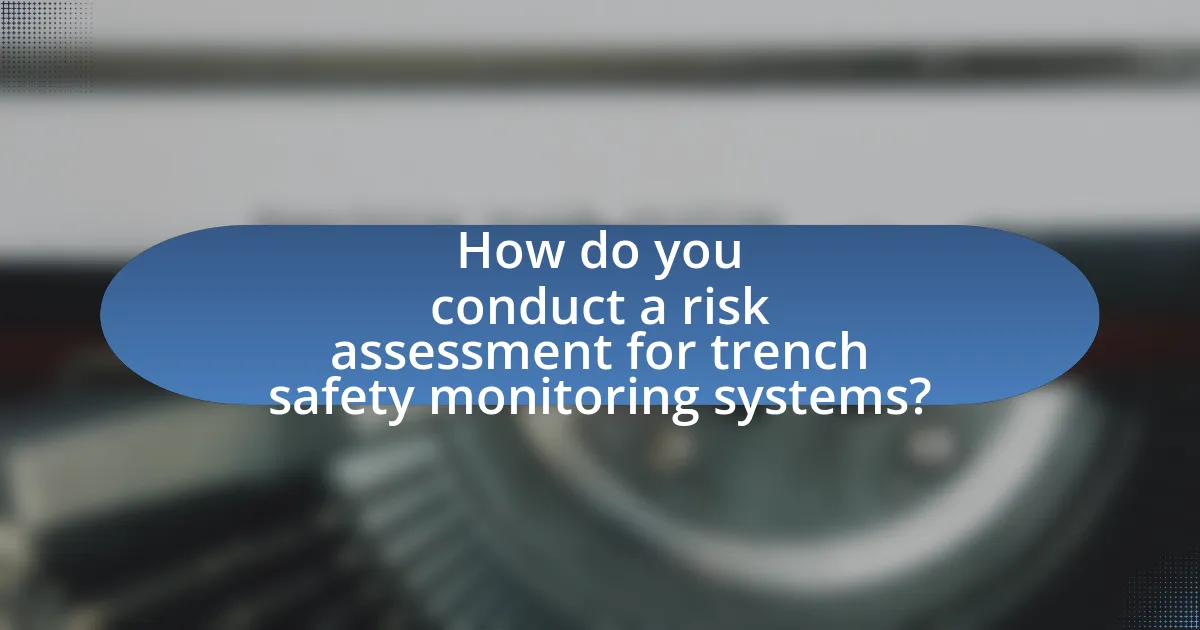
How do you conduct a risk assessment for trench safety monitoring systems?
To conduct a risk assessment for trench safety monitoring systems, first identify potential hazards associated with trenching activities, such as cave-ins, falling loads, and hazardous atmospheres. Next, evaluate the likelihood and severity of these hazards by analyzing historical data and incident reports, which indicate that trench collapses account for a significant percentage of excavation-related fatalities. Then, implement control measures, including proper shoring, monitoring systems, and worker training, to mitigate identified risks. Finally, document the assessment process and regularly review and update it to reflect changes in site conditions or regulations, ensuring compliance with safety standards such as OSHA regulations, which mandate specific safety protocols for trenching operations.
What steps are involved in performing a risk assessment?
The steps involved in performing a risk assessment include identifying hazards, analyzing risks, evaluating risks, and implementing control measures. First, identifying hazards involves recognizing potential sources of harm, such as unstable soil or equipment failure in trench safety monitoring systems. Next, analyzing risks entails assessing the likelihood and consequences of these hazards, which can be quantified using historical data or expert judgment. Following this, evaluating risks requires prioritizing them based on their severity and likelihood, often using a risk matrix. Finally, implementing control measures involves developing strategies to mitigate identified risks, such as using protective equipment or redesigning trench layouts to enhance safety. These steps are essential for ensuring the safety and effectiveness of trench safety monitoring systems.
How do you gather data for the assessment?
Data for the assessment is gathered through a combination of site inspections, interviews with personnel, and analysis of historical incident reports. Site inspections allow for direct observation of trench conditions and safety practices, while interviews provide insights into worker experiences and safety protocols. Analyzing historical incident reports helps identify patterns and areas of concern, ensuring a comprehensive understanding of risks associated with trench safety monitoring systems. This multi-faceted approach ensures that the data collected is accurate and relevant, facilitating a thorough risk assessment.
What tools and techniques are used in the assessment process?
The tools and techniques used in the assessment process for trench safety monitoring systems include risk matrices, checklists, and software modeling tools. Risk matrices help prioritize risks based on their likelihood and impact, allowing for effective decision-making. Checklists ensure that all safety protocols and potential hazards are systematically evaluated. Software modeling tools, such as finite element analysis, simulate trench conditions to predict potential failures and assess safety measures. These methods are validated by industry standards and best practices, ensuring comprehensive risk assessment and management in trench safety.
How do you evaluate and prioritize risks identified in the assessment?
To evaluate and prioritize risks identified in the assessment, one must first assess the likelihood and impact of each risk. This involves categorizing risks based on their potential severity and the probability of occurrence, often using a risk matrix. For instance, risks that could lead to severe injuries or fatalities in trench safety monitoring systems should be prioritized higher than those with minor consequences.
Additionally, historical data on trench incidents can provide context, demonstrating that improper monitoring has led to significant accidents, thus reinforcing the need for prioritization. By focusing on high-likelihood and high-impact risks, organizations can allocate resources effectively to mitigate the most critical threats to safety.
What criteria are used to assess the severity of risks?
The criteria used to assess the severity of risks include the likelihood of occurrence, potential impact on health and safety, and the extent of financial loss. Likelihood evaluates how probable it is for a risk to materialize, while potential impact assesses the consequences of that risk on individuals and operations. Financial loss considers the economic implications of the risk event. These criteria are essential in prioritizing risks and determining appropriate mitigation strategies in trench safety monitoring systems, as outlined in industry standards such as ISO 31000, which emphasizes a structured approach to risk management.
How can you rank risks to determine focus areas?
To rank risks and determine focus areas, utilize a risk assessment matrix that evaluates the likelihood and impact of each risk. This method allows for the systematic categorization of risks based on their severity and probability of occurrence, enabling prioritization of focus areas. For instance, risks that are both highly likely to occur and have severe consequences should be addressed first, while those with lower likelihood and impact can be monitored or managed with less urgency. This approach is supported by risk management frameworks such as ISO 31000, which emphasizes the importance of structured risk evaluation to enhance decision-making and resource allocation in safety monitoring systems.
What role does communication play in the risk assessment process?
Communication is essential in the risk assessment process as it facilitates the exchange of critical information among stakeholders, ensuring that all relevant risks are identified and understood. Effective communication allows for the sharing of insights regarding potential hazards, the evaluation of risk levels, and the development of appropriate mitigation strategies. For instance, in trench safety monitoring systems, clear communication among engineers, safety personnel, and workers can lead to timely identification of unsafe conditions, thereby reducing the likelihood of accidents. Studies have shown that organizations with robust communication practices experience fewer incidents, highlighting the direct correlation between effective communication and enhanced safety outcomes in risk management.
How should findings be reported to stakeholders?
Findings should be reported to stakeholders through clear, concise, and structured communication methods such as presentations, written reports, and executive summaries. These formats ensure that stakeholders can easily understand the key insights and implications of the risk assessment for trench safety monitoring systems. For instance, using visual aids like charts and graphs can enhance comprehension of complex data, while summarizing critical findings in bullet points allows for quick reference. Additionally, providing actionable recommendations based on the findings can facilitate informed decision-making among stakeholders.
What strategies can enhance communication about risks?
Effective strategies to enhance communication about risks include utilizing clear and concise language, employing visual aids, and fostering an open dialogue. Clear language minimizes misunderstandings, while visual aids such as charts and graphs can illustrate complex data effectively. Open dialogue encourages stakeholders to ask questions and express concerns, which can lead to a more comprehensive understanding of the risks involved. Research indicates that organizations that prioritize effective risk communication experience fewer incidents and improved safety outcomes, highlighting the importance of these strategies in risk management.
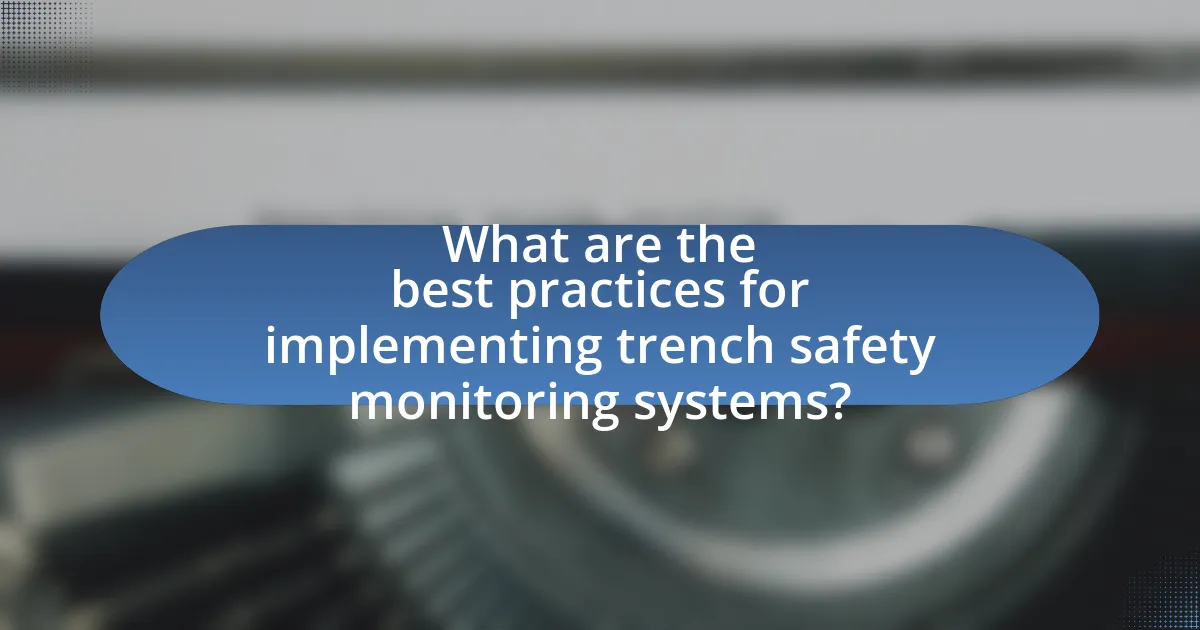
What are the best practices for implementing trench safety monitoring systems?
The best practices for implementing trench safety monitoring systems include conducting thorough risk assessments, utilizing advanced monitoring technologies, and ensuring regular training for personnel. Risk assessments should identify potential hazards such as soil instability and water accumulation, which can lead to trench collapses. Advanced monitoring technologies, such as real-time sensors for soil movement and environmental conditions, provide critical data to prevent accidents. Regular training ensures that workers are aware of safety protocols and can respond effectively to emergencies. According to the Occupational Safety and Health Administration (OSHA), proper implementation of these practices significantly reduces the risk of trench-related incidents, which are responsible for approximately 100 fatalities annually in the United States.
How can you ensure continuous monitoring and improvement?
To ensure continuous monitoring and improvement in trench safety monitoring systems, implement a systematic approach that includes regular data collection, analysis, and feedback loops. This involves utilizing real-time monitoring technologies to gather data on trench conditions, which can then be analyzed to identify trends and areas for improvement. For instance, studies show that integrating automated monitoring systems can reduce incidents by up to 30% by providing timely alerts and actionable insights. Regular training and updates for personnel based on the analyzed data further enhance safety protocols, ensuring that improvements are effectively integrated into daily operations.
What methods can be used for ongoing risk assessment updates?
Ongoing risk assessment updates can be achieved through continuous monitoring, regular audits, and stakeholder feedback. Continuous monitoring involves the use of technology and sensors to track real-time conditions in trench safety, allowing for immediate identification of risks. Regular audits ensure that safety protocols are being followed and that any changes in the environment or operations are assessed. Stakeholder feedback, including input from workers and safety personnel, provides valuable insights into potential hazards and areas for improvement. These methods collectively enhance the effectiveness of risk assessments in trench safety monitoring systems.
How do you incorporate feedback into safety practices?
Incorporating feedback into safety practices involves systematically collecting, analyzing, and implementing suggestions from employees and stakeholders to enhance safety protocols. Organizations can establish regular feedback mechanisms, such as surveys or safety meetings, to gather insights on existing safety measures. For instance, a study by the National Institute for Occupational Safety and Health (NIOSH) found that workplaces that actively solicit and act on employee feedback experience a 30% reduction in workplace accidents. This data underscores the importance of integrating feedback into safety practices to create a safer work environment.
What common challenges arise during risk assessments for trench safety?
Common challenges during risk assessments for trench safety include identifying potential hazards, ensuring compliance with regulations, and evaluating the effectiveness of safety measures. Identifying hazards can be complicated due to the dynamic nature of trench environments, where soil conditions, weather, and nearby structures can change rapidly. Compliance with regulations, such as those set by the Occupational Safety and Health Administration (OSHA), requires thorough knowledge and understanding of specific guidelines, which can be overwhelming for some assessors. Additionally, evaluating the effectiveness of existing safety measures often involves subjective judgment, making it difficult to quantify risk accurately. These challenges can lead to inadequate assessments and increased safety risks for workers in trenching operations.
How can you overcome resistance to risk assessment processes?
To overcome resistance to risk assessment processes, engage stakeholders early and communicate the benefits clearly. Involving team members in the risk assessment process fosters ownership and reduces apprehension. Research indicates that organizations that prioritize transparent communication and collaborative approaches experience a 30% increase in compliance with safety protocols. By demonstrating how risk assessments enhance safety and efficiency, you can effectively mitigate resistance.
What are the pitfalls to avoid in trench safety assessments?
The main pitfalls to avoid in trench safety assessments include inadequate soil analysis, neglecting to assess environmental conditions, and failing to implement proper protective systems. Inadequate soil analysis can lead to misjudgments about soil stability, increasing the risk of collapses; for instance, the Occupational Safety and Health Administration (OSHA) emphasizes the importance of classifying soil types accurately to ensure safety. Neglecting environmental conditions, such as weather changes or nearby vibrations, can compromise trench integrity, as heavy rainfall can saturate soil and increase collapse risk. Lastly, failing to implement proper protective systems, like trench boxes or shoring, can expose workers to hazardous conditions, which OSHA regulations specifically require to mitigate risks in excavation sites.
What practical tips can enhance trench safety monitoring systems?
Implementing real-time monitoring technologies, such as sensors for soil movement and water levels, can significantly enhance trench safety monitoring systems. These technologies provide immediate alerts for potential hazards, allowing for timely interventions. For instance, studies have shown that using geotechnical sensors can reduce trench-related accidents by up to 30% by providing critical data on ground stability. Additionally, regular training for workers on recognizing signs of trench instability and proper safety protocols further strengthens the effectiveness of monitoring systems.
How can technology improve trench safety monitoring?
Technology can improve trench safety monitoring by utilizing real-time data collection and analysis through sensors and monitoring systems. These technologies, such as ground-penetrating radar and smart sensors, can detect soil movement, water accumulation, and other hazardous conditions that may compromise trench stability. For instance, a study by the National Institute for Occupational Safety and Health (NIOSH) highlights that implementing automated monitoring systems can reduce accidents by providing timely alerts to workers about potential dangers. Additionally, the integration of drones for aerial surveillance can enhance visibility and assessment of trench conditions, further ensuring worker safety.
What training is essential for personnel involved in trench safety?
Personnel involved in trench safety must undergo specific training that includes understanding trench hazards, proper use of protective systems, and emergency response procedures. This training is essential to ensure compliance with safety regulations, such as those outlined by the Occupational Safety and Health Administration (OSHA), which mandates that workers receive training on recognizing and avoiding unsafe conditions in trenches. Additionally, training should cover soil analysis, the use of protective equipment, and the implementation of safety measures to prevent cave-ins, which are a leading cause of fatalities in trench work.
